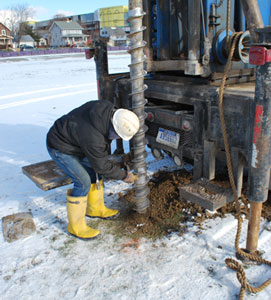Environmental Indicators: Phosphorus
Editor’s Note: This is the third in a series written by Ann Arbor city staff on the environmental indicators used by the city of Ann Arbor in its State of Our Environment Report.
The State of Our Environment Report is developed by the city’s environmental commission and designed as a citizen’s reference tool on environmental issues and as an atlas of the management strategies underway that are intended to conserve and protect our environment. The newest version of the report is organized around 10 environmental goals developed by the environmental commission and adopted by the city council in 2007.

Phosphorus takes its place in the periodic table of elements with atomic number 15. Too much P is not good for the Huron River.
This installment focuses on phosphorus levels in our creeks and river. Adrienne Marino is a recent graduate of the University of Michigan School of Natural Resources and Environment and is an Environmental Programs Assistant with the city of Ann Arbor. Matthew Naud is the Environmental Coordinator at the city of Ann Arbor and can be reached at mnaud@a2gov.org. Elizabeth Riggs with the Huron River Watershed Council and Molly Wade with the city of Ann Arbor provided additional input on the regulatory issues.
All installments of the series are available here: Environmental Indicator Series.
April showers will surely give way to May flowers and the start of lawn care season in southeast Michigan. As you tend to your lawn this spring and summer, you should know that your choices regarding lawn maintenance – especially fertilizer application – have large and measurable effects on the health of the Huron River and on the natural and human communities who depend on it.
How do we know this? The city of Ann Arbor’s ordinance regulating phosphorus-based lawn fertilizers took effect at the beginning of 2007. And sampling of Huron River phosphorus levels by University of Michigan scientists shows significant decreases in total phosphorus levels in 2008 and 2009. Huron River Watershed Council sampling of the creeksheds support these findings. [Full Story]




